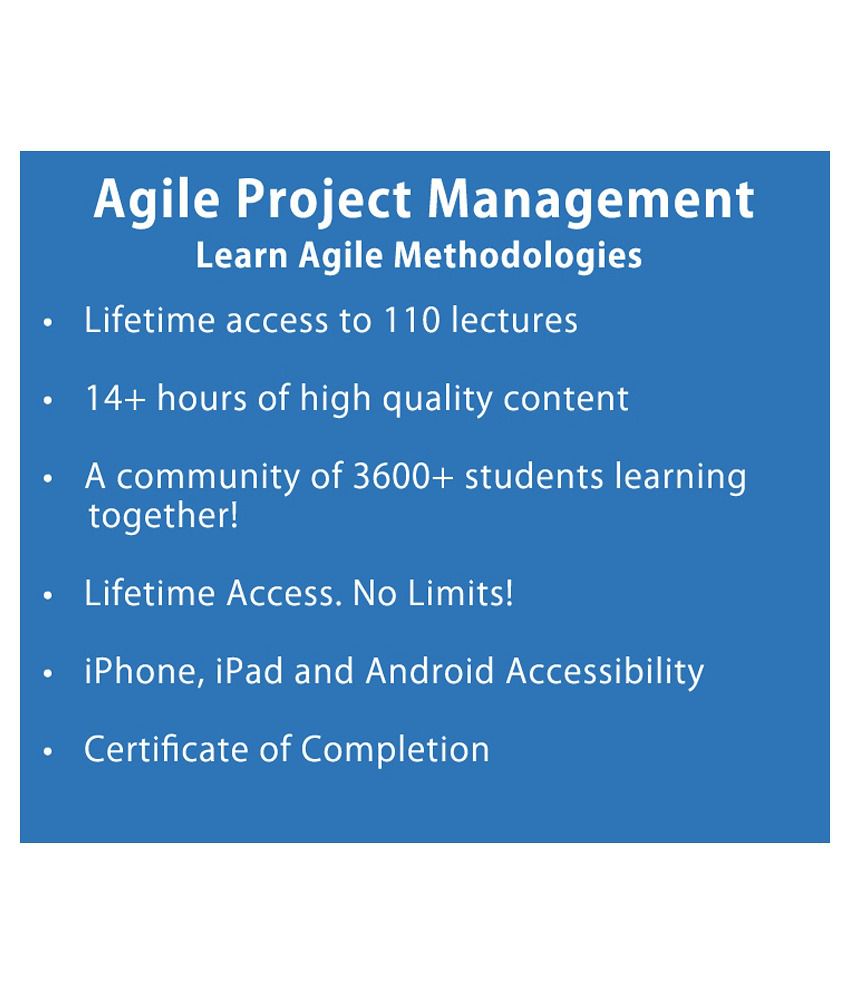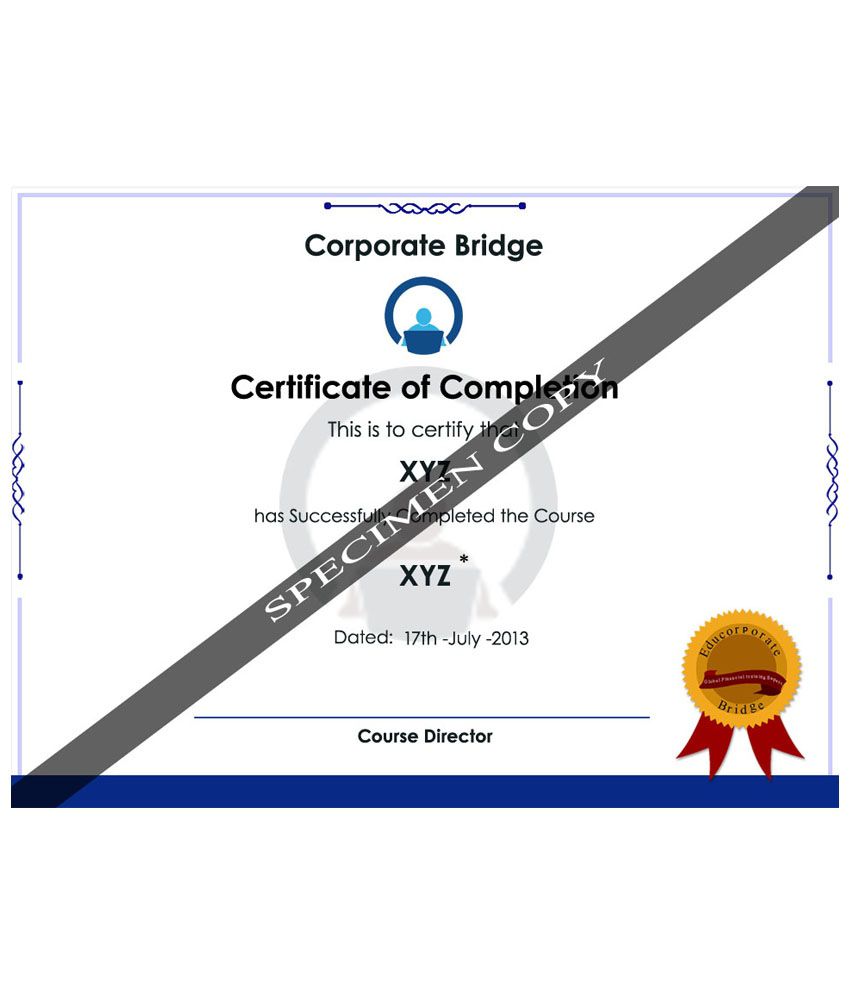![]()
Syste
m (Hardware/Software)
Requirements
| Operating
Software | Windows XP or
Higher
| | Processor | Minim
um P4 or Higher
| | RAM | 1 GB or
Higher
| | Browser | Any
| | Recommended Internet
Speed | Minimum 1MBPS
| | Supported Browser
Plug-ins | * Updated
Flash Player, * Update Java
| | Other
Requirements | Speaker or
headphone | |
Prdocut DescriptionMany of today's smart software organizations have ditched unforgiving waterfall project management for an agile approach. Agile project management allows Project Managers to hit key milestones and provide executives with fast, accurate project status even when the deliverable is a moving target. By having greater visibility and continuous feedback, agile PMOs can react very quickly to change and bottlenecks in the development process, delivering better software, faster.Agile project management is a value-driven approach that allows Project Managers to deliver high-priority, high-quality work.
Software projects change constantly. When customers are expected to finalize requirements before they can test-drive the prototypes, overhead and long delays often cripple the project. Agile Project Management is about embracing change, even late in the development stage. It's about delivering the features with the greatest business value first, and having the real-time information to tightly manage cost, time and scope. Agile Project Management reduces complexity by breaking down the many-months-long cycle of building requirements for the whole project, building the entire product and then testing to find hundreds of product flaws. Instead small, usable segments of the software product are specified, developed and tested in manageable, two- to four-week cycles.
In this course on Agile Project Management, we will be dealing with the following modules:
Agile Project Management FrameworkAgile Planning, Monitoring & AdoptingAgile EstimationAgile CommunicationAgile Analysis & designAgile QualitySoft / Interpersonal skill / Negotiation as PMValue based prioritizationAgile Risk ManagementAgile MetricsAgile value stream AnalysisKnowledge & SkillsCourse Curriculum
Section1:INTRODUCTION
Lecture1:Introduction
Section2:AGILE
Lecture2:Agile Approaches
Lecture3:Customer Collaboration
Lecture4:Responding to Change
Lecture5:Agile's 12 Principles
Lecture6:Values, Agile Framework
Lecture7:Agile Team composition
Lecture8:Team composition Contnues
Section3:SCRUM
Lecture9:Introduction to scrum Practices
Lecture10:Product Owner, Scrum Masters, The Team
Lecture11:Scrum
Lecture12:sprint meetings
Lecture13:sprint reviews
Lecture14:DAILY SCRUM
Lecture15:RETROSPECTIVE
Lecture16:SPRINT MEETINGS
Lecture17:MORE ON SPRINT MEETINGS
Lecture18:INCREMENT
Section4:USER STORIES
Lecture19:Introduction to user stories
Lecture20:Epics
Lecture21:Epics & themes
Lecture22:What is good user story?
Lecture23:What is good user story? Continues
Lecture24:More on What is good user story?
Lecture25:how to write good user story?
Lecture26:how to write good user story Continues
Lecture27:Role & responsibilities
Section5:ESTIMATION
Lecture28:Introduction to estimation
Lecture29:Measure of Size
Lecture30:what is ideal day?
Lecture31:What is elapsed time?
Lecture32:Story Points
Lecture33:What is estimation?
Lecture34:How to do estimation?
Lecture35:Planning poker an estimation technique
Lecture36:Planning Poker 2
Lecture37:What is re-estimation?
Section6:VBP (VALUE BASED PRIORITIZATION)
Lecture38:Introduction to prioritization
Lecture39:What is risk priority
Lecture40:Value based prioritization
Lecture41:Kano model
Lecture42:Financial values
Lecture43:IRR, NPV, Payback
Lecture44:Minimum marketable features 1
Lecture45:Minimum marketable features 2
Lecture46:Minimum marketable features 3
Section7:PLANNING
Lecture47:introduction to planning
Lecture48:advantages of last minute planning
Lecture49:time boxing
Lecture50:what is release plan
Lecture51:advantages of release planning
Lecture52:what is iteration plan
Lecture53:participatory decision making
Lecture54:Framing
Lecture55:Decision making
Lecture56:Non-Unanimous Consensus
Lecture57:Decision Retrospective
Section8:MONITORING
Lecture58:Monitoring Introduction
Lecture59:Tools used for Monitoring
Lecture60:Monitoring
Section9:RETROSPECTIVE
Lecture61:what is retrospective?
Lecture62:retrspective structure
Lecture63:Gather Data, Generate Insights
Lecture64:Decide what to do, Closure, Why Retrospective Activities?
Lecture65:Activities to Gather Data, Generate Insights
Lecture66:Activities for Closure, Preparation, Leading the Perspectives
Lecture67:Retrospective Types
Section10:XP (XTREME PROGRAMMING)
Lecture68:XP Introduction
Lecture69:XP Comprises of, What makes XP Different
Lecture70:XP Values
Lecture71:Simplicity, Feedback, Courage
Lecture72:Respect
Lecture73:Introduction to XP Practices
Lecture74:XP Corollary Practices
Lecture75:Additional XP Practices
Lecture76:XP Lifecycle
Lecture77:XP Practice deep dive
Lecture78:Continuous Integration
Lecture79:Test First Development
Lecture80:Pair Programming, XP practices
Lecture81:Spike Solutions, Exploratory Testings
Lecture82:Agile Practices and Grouping
Lecture83:Releasing, Planning, Developing
Lecture84:Practice Quiz
Section11:LEAN
Lecture85:Lean Goals
Lecture86:Eliminate Wastes
Lecture87:Eliminate Wastes, Build Quality In
Lecture88:Create Knowledge
Lecture89:Value Stream Mapping
Lecture90:Kanban
Lecture91:Kanban and Pull System
Section12:COMMUNICATION
Lecture92:Communication
Lecture93:Elements of Active Listening, Information Radiator, Ideal Team Space
Lecture94:Not so good Team space, Distributed vs Collocated Team, Engaging Stakeholders
Section13:RISK MANAGEMENT
Lecture95:What is Risk?
Lecture96:Organic Risk Management in Agile
Lecture97:Mitigating Risk Organically
Lecture98:Response
Section14:GOVERNANCE
Lecture99:PMO
Lecture100:Metrics
Lecture101:Agile Metric
Lecture102:Agile Metric Continues
Lecture103:Agile Compliance, Chartering, Control Limits
Lecture104:Agile Contract Types
Lecture105:EVM Terms, Measuring Metrics, Escaped Defects
Section15:Soft skill
Lecture106:Soft skill Part 1
Lecture107:Soft skill Part 2
Lecture108:Conflict Management
Lecture109:Agile leadership
Lecture110:Agile Coaching
Benefits
eduCBA e-campus
Virtual campus powered by robust LMS which enables to study through internet with cutting edge features
Online Video Training Material
Presentation Slides
USP of the product
* 24 x 7 online access* Learn from tutorials curated by expert industry professionals and trainers* Certificate of Completion* Practical application oriented skillsHow to use? (Steps to use Study Material)
Step 1 - eduCBA sends the redemption coupon along with the registration link. Step 2 - Student will register with his register email id and coupon Step 3 - Student receive the course access and password on his/her email idStep 4 - Login using your email id and password and start learningTo get more information, you may want to watch the video below
Learn Everything, Anywhere, Anytime
India's Largest Online Education Marketplace


